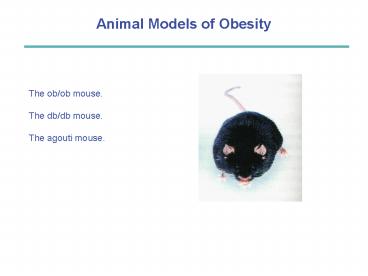Animal Models of Obesity - PowerPoint PPT Presentation
1 / 13
Title: Animal Models of Obesity
1
Animal Models of Obesity
The ob/ob mouse. The db/db mouse. The agouti
mouse.
2
First, an interesting story about fat mice.
3
Animal Models of Obesity
- first and second animal models of obesity were
identified by an animal technician at Jackson
Laboratories - both types of obese mice were due to a
spontaneous genetic mutation - called obese mouse (ob/ob mouse) and the
diabetic mouse (db/db mouse)
4
Animal Models of Obesity
- first identified by Coleman at the Jackson Lab
(Bar Harbor, Maine) in 1950s - obese mice show a distinctive obese phenotype
- litter characteristics suggested that the
mutation involved a single gene - about ¼ of each litter developed obesity
- ob/ob mouse obese
- OB/OB mouse lean
- OB/ob mouse lean
- subsequently discovered that the mutation was
on chromosome 6
1) The ob/ob Mouse
- involves the gene that encodes ob protein
(leptin)
5
- PHENOTYPE OF THE ob/ob MOUSE
- defect in thermogenesis by P3
- fat mass is increased by P14
- hyperphagia and obesity by P21 (increase in
meal size) - hypothermic as adults
- hyperglycemic
- mild increase in plasma insulin
- mild form of diabetes
- decreased metabolic rate
- decreased activity (?)
6
Leptin Decreases Body Weight in Obese and Lean
Rats
Genetically Obese Mouse Vehicle
Genetically Obese Mouse Leptin
7
(No Transcript)
8
Animal Models of Obesity
2) The db/db Mouse
- phenotype was also identified in the 1950s
- diabetic mice show a distinctive obese phenotype
- litter characteristics suggested that the
mutation involved a single gene - about ¼ of each litter developed obesity
- db/db mouse obese
- DB/DB mouse lean
- DB/db mouse lean
- subsequently discovered that the mutation was
on chromosome 4 - involves the gene that encodes the long form of
the leptin receptor (Ob-R)
9
- PHENOTYPE OF THE db/db MOUSE
- diabetic mice show a distinctive phenotype
(very similar to ob/ob mouse) - fat mass is increased by P14
- hyperphagia and obesity by P21
- hypothermic as adults
- hyperglycemic
- hyperinsulinemic
- diabetic
- decreased metabolic rate
10
Animal Models of Obesity
- 3) Agouti Mouse (AY/a)
- phenotype was identified in the 1960s
- these mice show a distinctive obese phenotype
- obesity is due to a mutation in the gene
(agouti) that is expressed on chromosome 2 and
encodes agouti protein - dominant mutation results in ectopic expression
of agouti protein
Wild type
Agouti
Interesting genetics heterozygote (Ay/a)
obese/yellow homozygote (Ay/Ay)
fatal homozygote (a/a) lean/black
11
- PHENOTYPE OF THE AGOUTI MOUSE
- hyperphagia and obesity by 6-8 weeks (adult
onset) - obesity is mild to moderate enhanced by a high
fat diet - hyperinsulinemic
- increased linear growth long tails
- decreased metabolic rate
- normal thermoregulation
- activity levels have not been studied
- yellow coat color at birth
- unaffected litter mates have a black coat color
Agouti
- WHY A YELLOW COAT ???
- normally, agouti protein is expressed only in
hair follicles and the testes - over-expression of agouti protein peripherally
produces yellow hair pigment - results in yellow
coat color - expression of agouti protein centrally
- produces the obese phenotype
12
- obesity arises because agouti protein is an
endogenous antagonist of MC4-R - antagonism of MC4-R produces
- hyperphagia
- decreased metabolic rate
- insensitivity to leptin
- together, this produces an
- obese phenotype
-
agouti
13
(No Transcript)































